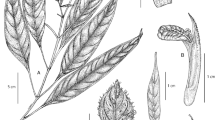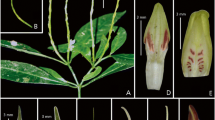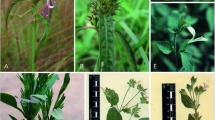Summary
Two new species of Acanthaceae from Bolivia are described, illustrated and discussed: Stenostephanus suburceolatus from Andean hill forest and Justicia calzadillae from the Amazonian lowlands. Notes on Stenostephanus in Bolivia are also provided.
Similar content being viewed by others
Avoid common mistakes on your manuscript.
A full account of the Acanthaceae of Bolivia was published by Wasshausen & Wood in 2004 but since then there has been a steady increment of new records and new species. These additional discoveries were summarised by Wood (2012) but since then two additional species have been found to bring the total number of Acanthaceae in Bolivia to 185 species of which 173 are native. The two new species are described below.
Stenostephanus
Stenostephanus Nees is an American genus characteristic of moist cloud forest in mountainous regions from southern Mexico south to central Bolivia with an outlying population in the Brazilian Mata Atlantica. It reaches its greatest diversity in Colombia where 33 species are recognised (Wood 2009). Throughout its range most species have a restricted distribution and are difficult to find. This is a reflection in part of their rarity but also of their erratic flowering patterns. One species has been demonstrated to be plietesial (Daniel 2006) and others appear to flower at irregular intervals (Wood 1988: 19).
Nine species were hitherto known from Bolivia (Wasshausen & Wood 2004, 2015) and the newly described species below brings the total to ten. Of these, nine appear to be endemic to Bolivia and all are rare and probably at least Vulnerable within IUCN conservation categories. However, very little reliable information is available about the size and condition of the populations other than their basic distribution. They are restricted to the wet, eastern Andean slopes from the Santa Cruz area north to the Peruvian border. They grow in moist Andean hill forest from about 300 m in the foothills to around 3000 m and many are probably pollinated by humming birds. The three species with a 2-lipped corolla found in Bolivia (Stenostephanus cochabambensis Wassh., S. davidsonii Wassh. and S. pyramadalis Lindau) occur at higher altitudes (2000 – 3000 m) and are more typical of true cloud forest than the six species with a subequally lobed corolla. The new species belongs to this latter group.
Stenostephanus suburceolatus J. R. I. Wood, sp. nov. Type: Bolivia, La Paz, Prov. Abel Iturralde, Parque Nacional Madidi, Asariamas, entre San Martín y Rancho Chico, 1382 m, 29 June 2013, A. Fuentes 18450 (holotype LPB; isotypes K, MO).
http://www.ipni.org/urn:lsid:ipni.org:names:77148137-1
Perennial herb reaching at least 30 cm in height (1 m according to field notes); stem dark green, thinly crisped-hairy. Leaves isophyllous, petiolate; petiole 1.5 – 5 cm long, shortly villous with crisped, brownish multicellular hairs; lamina 7 – 12.5 × 3.5 – 6.5 cm, ovate to ovate-elliptic, base broadly cuneate, slightly asymmetric, margin entire to slightly undulate, shortly ciliate, apex acuminate; lateral veins c. 9 pairs; adaxial surface dark green with linear cystoliths, hirsute with scattered stiff whitish hairs, these more dense on the veins; abaxial surface paler with weakly reticulate venation, the mid vein shortly villous with crisped brownish multicellular hairs, the side veins markedly less hirsute, the intercostal regions glabrous or nearly so. Inflorescence of pedunculate axillary racemes arising in the upper leaf axils; peduncles 5.5 – 8 cm, densely villous with crisped, brownish multicellular hairs; bracts 4 – 5.5 × 1.5 – 2.5 cm, paired, foliose, sessile, ovate-elliptic, acuminate, indumentum similar to that of the leaves; rhachis 3 – 4 cm, densely villous with whitish hairs, naked below, floriferous above; flowers in opposite pairs, subsessile with pedicels 0 – 1 mm long; bracteoles c. 2 × 0.25 mm, very narrowly linear-deltoid terminating in a long fine point; calyx subequally 5-lobed to base, the lobes 7 – 8 × 0.5 – 0.75 mm, linear, acuminate, pallid; corolla 21 – 22 mm long, suburceolate, the basal cylindrical part 7 × 1.5 – 2 mm, then abruptly widened to 7 mm before being narrowed slightly at the mouth, 4-lobed, the lobes subequal, 1.5 mm long and wide, ovate-triangular, exterior of corolla magenta, glandular-pubescent, interior of lobes deep pink; stamens 2, exserted 5 – 6 mm; filaments 15 – 17 mm, inserted at top of basal cylindrical part, thinly pilose below, glabrous above; anthers 2.5 × 0.5 mm, linear-oblong, 1-celled; style 22 – 24 mm, exserted, glabrous except for a few hairs at base; ovary c. 2 mm long, linear-lanceolate in outline, glabrous, basal disc prominent. Capsule and seeds not seen. Figs 1 – 2.
recognition. Stenostephanus suburceolatus has a subequally 4-lobed corolla and so clearly belongs to the group of Stenostephanus species once placed in Hansteinia Oerst. Amongst Bolivian species it is closest to S. lyman-smithii Wassh. but that species has a distinctly long-spicate terminal inflorescence very different from the short axillary racemes of S. suburceolatus. Additionally the corolla of S. lyman-smithii is only 15 – 18 mm long and glabrous except for a few hairs near the apex. The strongly exserted stamens of S. suburceolatus recall those of S. longistaminus (Ruiz & Pavon) V. M. Baum but that species has a glabrous corolla and a terminal inflorescence. The most similar species to S. suburceolatus is represented by a specimen of an undescribed species at Kew from Cusco in Peru. This has the same short axillary racemes but they are subsessile, the corolla is shorter and the calyx lobes broader. It is hoped to describe this later in a paper on Stenostephanus in Peru.
distribution. This species is only known from the type collection from the Madidi National Park in Bolivia close to the frontier with Peru.
specimens examined. bolivia. La Paz, Prov. Abel Iturralde, Parque Nacional Madidi, Asariamas, entre San Martín y Rancho Chico. Bosque basimontano inferior pluviestacional húmedo, con bastantes elementos amazónicos, con Terminalia oblonga Steud. y Pouteria spp. 14°09'03"S 068°44'12"W, 1382 m, 29 June 2013, A. Fuentes 18450 (holotype LPB; isotypes K, MO).
habitat. A rare species of moist Andean hill forest at almost 1400 m.
conservation status. Only known from a single recent collection so correctly Data Deficient according to IUCN (2012) guidelines. However, it is the first time it has been collected during the intensive studies of the flora of the Madidi National Park by Alfredo Fuentes and his team and, unless it is pliestesial, it is therefore very rare and will probably prove to be at least Endangered (EN) within IUCN guidelines when the population is properly assessed. Fortunately it grows within a legally protected area with a high profile nationally and internationally so habitat destruction is unlikely.
Justicia
Justicia L. is the largest genus of Acanthaceae worldwide and is very diverse in the neotropics. In Bolivia it is much the largest genus of Acanthaceae with 73 species (69 native) after the inclusion of the novelty described below.
Justicia calzadillae J. R. I. Wood sp. nov. Type: Bolivia, Pando: Prov. Madre de Dios, Loc. Las Ruinas, aproximadamente a 2 km de la comunidad Las Piedras, sobre un camino a un lado de la carretera que va a Las Piedras, 144 m, 25 Aug. 2007, D. Rocabado & E. Calzadilla 950 (holotype USZ; isotype K).
http://www.ipni.org/urn:lsid:ipni.org:names:77148138-1
Probably perennial herb to at least 40 cm; stem rounded, thinly pilose with long, spreading gland-tipped hairs. Leaves isophyllous, petiolate; petioles 1 – 2 cm, bifariously hirsute with a mixture of abundant short, crisped hairs and scattered, long, spreading trichomes; lamina 6 – 13 × 2.5 – 5 cm, narrowly ovate to oblong-ovate, base attenuate and shortly decurrent onto the petiole, margin entire, thinly and shortly ciliate, especially towards the base, apex acuminate and obtuse, adaxial surface very sparsely pilose with long stiff hairs, the midvein crisped-villous and with scattered long trichomes, abaxial surface ±glabrous except for crisped hairs on veins. Inflorescence of axillary panicles; bracts 0.7 – 2 × 0.1 – 0.4 cm, diminishing in size upwards, narrowly oblong, thinly hirsute; rhachis hirsute with crisped hairs mixed with scattered long trichomes and abundant cystoliths, branches cymose in structure, the flowers in opposite pairs or with a single flower arising opposite a branchlet, indumentum similar to that of rhachis but lacking long trichomes; bracteoles 2 – 3 × 0.25 mm, filiform, sometimes slightly widened at base, subglabrous or with a few scattered hairs; calyx 3 mm long, subequally 5-lobed to the base, lobes narrowly linear-lanceolate, glabrous; corolla 12 – 13 mm long, pale lilac, glabrous on the exterior, divided into 2 lips c. 7 mm above base; tube ±cylindrical, gradually widened from c. 0.75 mm at base to 1.5 mm at mouth; upper lip c. 6 mm long, elongate-triangular in form, entire; lower lip 4 – 5 mm long, throat with prominent honey guides, 3-toothed, the teeth rounded, c. 0.5 mm long; stamens included, filaments 4 mm, glabrous, thecae at same level, 0.5 – 0.75 mm long, ellipsoid, lacking basal appendages; style 10 mm, glabrous, stigma very small, ovary 1 mm. Capsule 13 – 14 × 3 mm, clavate, apiculate, glabrous, 4-seeded; seeds c. 1.25 mm long and wide, lenticular, minutely aculeate. Fig. 3.
recognition. This species bears a striking resemblance to Justicia monachinoi Wassh. from Venezuela in its habit, leaf shape, inflorescence structure and corolla. However the inflorescence is more delicate with slender branches, the bracteoles filiform, <0.25 mm wide (not lanceolate) and the calyx, very short, only 3 mm (not 4 – 5 mm) long. Additionally the adaxial surface of the leaves is glabrous to very sparsely pilose with scattered long appressed hairs whereas in J. monachinoi it is quite densely covered in bulbous-based hairs. Additionally the corolla is narrower at the base (0.75 vs 1.5 mm) more slender and slightly longer (12 – 13 vs 9 – 10 mm), and the capsule is glabrous, not puberulent.
It does not appear to be very close to any species hitherto known from Bolivia but in Wasshausen & Wood (2004: 44) it would key into Group B of Justicia (plants with paniculate inflorescence). Within this group it would key out as J. dryadum Wassh. & J. R. I. Wood as long as the scattered trichomes on the leaf surface were noted. However it differs in its eglandular, glabrous calyx, its smaller corolla and very sparse leaf indumentum. If the trichomes on the leaves were missed it would key out as J. yungensis Wassh. & J. R. I. Wood but that species has completely glabrous leaves with prominent cystoliths and puberulent calyx lobes. From both these species, J. calzadillae is distinguished by its glabrous (not glandular) capsule and open paniculate inflorescence with the branches spreading at a wide angle.
distribution. It is only known from a single collection in the Amazon lowlands. Its occurrence in Brazil might be expected.
specimens examined. bolivia. Pando: Prov. Madre de Dios, Loc. Las Ruinas, aproximadamente a 2 km de la comunidad Las Piedras, sobre un camino a un lado de la carretera que va a Las Piedras, 11°01'27"S 66°07'05"W 144 m, 25 Aug. 2007, D. Rocabado & E. Calzadilla 950 (holotype USZ; isotype K).
habitat. Found in low, dense tropical forest in Amazonian Bolivia. It is not recorded whether the forest was primary or secondary but the roadside habitat and density of the forest cover suggests secondary forest.
conservation status. This species should be provisionally classified as Data Deficient (DD). It is only known from a single collection and nothing is known of the extent or size of its population. Since it has not been previously collected it must be presumed to be rare and will probably merit categorisation as Endangered (EN) or some similar classification after proper study.
etymology. This species is named for Eliana Calzadilla, one of the collectors of this species. Besides her field work and studies of bryophytes, Eliana works as a botanical illustrator drawing both flowering plants and bryophytes. She is one of the authors of the Glosario illustrado para musgos neotropicales (Calzadilla & Churchill 2014).
References
Calzadilla, E. & Churchill, S. P. (2014). Glosario Ilustrado para Musgos Neotropicales. Missouri Botanical Garden Press, St Louis & Museo de Historia Natural, Santa Cruz.
Daniel, T. (2006). Synchronous Flowering and Monocarpy suggest plietesial life history for neotropical Stenostephanus chiapensis (Acanthaceae). Proc. Calif. Acad. Sci. 57: 1011 – 1018.
IUCN (2012). Guidelines for application of IUCN Red List Criteria at Regional and National Levels. International Union for the Conservation of Nature, Gland.
Wasshausen, D. C. & Wood, J. R. I. (2004). Acanthaceae of Bolivia. Contr. U.S. Natl. Herb. 49: 1 – 152.
____ & ____ (2015). Acanthaceae. In: P. M. Jorgensen, S. G. Beck & M. Nee (eds), Catálogo de las Plantas Vasculares de Bolivia, 179 – 192. Missouri Botanical Garden Press, St. Louis.
Wood, J. R. I. (1988). Colombian Acanthaceae — some new discoveries and some reconsiderations. Kew Bull. 43: 1 – 51.
____ (2009). New names, combinations and synonyms in Justicia and Stenostephanus (Acanthaceae). Kew Bull. 64: 49 – 55.
____ (2012). Two new species of Acanthaceae from Bolivia. Kew Bull. 67: 257 – 262.
Acknowledgements
Thanks are due to Alfredo Fuentes and Eliana Calzadilla for making available material of the new species and to the former for providing photographs to illustrate the habit and inflorescence of Stenostephanus suburceolatus. I am also grateful to Rosemary Wise for preparing the drawings.







